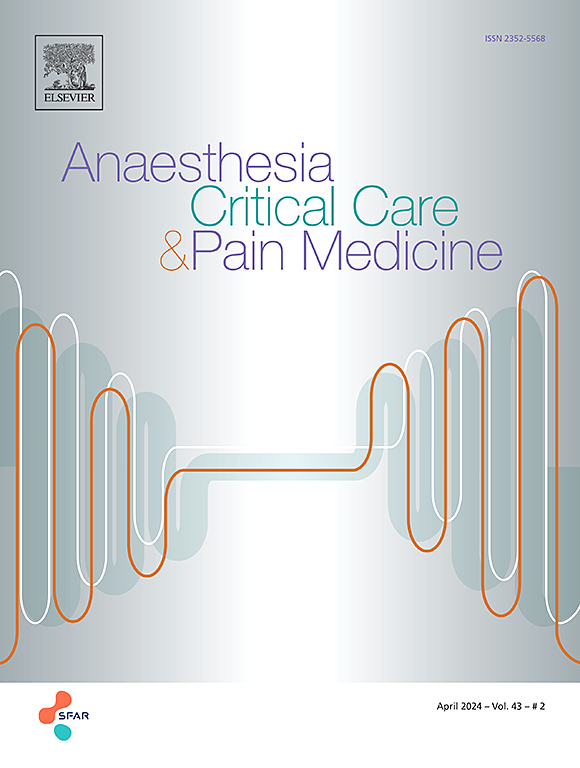Delphi study to develop a core outcome set for inpatient pain assessment after cesarean delivery
IF 4.7
3区 医学
Q1 ANESTHESIOLOGY
引用次数: 0
Abstract
Background
Studies of cesarean delivery pain report different outcomes, restricting data pooling. This study aimed to develop a core outcome set for inpatient postoperative pain assessment after cesarean delivery to use for research and clinical practice, using the Delphi consensus methodology.
Methods
A scoping review identified 37 initial outcomes, with 2 additional outcomes developed from a patient focus group. These were rated in a two-round Delphi survey process completed by a panel consisting of authors of studies identified from a scoping review (n = 9), supplemented with other experts (n = 5) and patients with recent lived experience of post cesarean delivery pain (n = 7). Scores were collected usinga 1−5 Likert scale, 1–2 being ‘critical for inclusion’; 3 being ‘important but not critical’, and 4–5 of ‘limited importance/invalid’. Outcomes were included if recommended by ≥70% of stakeholders after voting. A third-round virtual meeting determined domains, and several further rounds of online surveys finalizedthe specific measures.
Results
Round one included 14 experts and 7 patients (100% response). Round two included 12 experts and 4 patients (76% response). The virtual meeting was attended by 11 experts and 3 patients (67%), and the 4 online surveys were completed by 67%, 52%, 67%, and 76%. The final domains included pain intensity: at rest, movement-evoked, and pain relief; pain interference; total consumption of opioids; and maternal adverse effects. 12 measures for domains were agreed upon. Getting out of a hospital bed was selected as the most relevant functional activity for movement-evoked pain after cesarean delivery.
Conclusions
This core outcome set may be applied to future research and clinical practice initiatives to evaluate post cesarean delivery pain.
德尔菲研究为剖宫产后住院患者疼痛评估制定一个核心结局集。
背景:剖宫产疼痛的研究报告了不同的结果,限制了数据汇集。本研究旨在采用德尔菲共识方法,为剖宫产术后住院患者疼痛评估制定一套核心结果集,用于研究和临床实践。方法:范围评估确定了37个初始结果,另外2个结果来自焦点小组。在两轮德尔菲调查中对这些结果进行评分,该调查由焦点小组完成,该小组由范围综述研究的作者(n = 9)、其他专家(n = 5)和近期生活经验的患者(n = 7)组成。得分在1-5分的李克特量表上,1-2分是“关键的包容性”;3是“重要但不关键”,4-5是“有限重要/无效”。如果投票后有超过70%的利益相关者推荐,则纳入结果。第三轮虚拟会议确定了域名,并进一步进行了几轮在线调查,确定了具体措施。结果:第一轮专家14人,患者7人。第二轮包括12名专家和4名患者(76%应答)。参加虚拟会议的专家11人,患者3人(67%),完成4项在线调查的焦点组比例分别为67%、52%、67%、76%。最后一个领域包括疼痛强度:休息时、运动诱发时和疼痛缓解时;疼痛干扰;阿片类药物总消费量;以及母体的不良影响。就12项域名措施达成一致。结论:下床是剖宫产后运动诱发疼痛最相关的功能活动。这一核心结果集可以应用于未来的研究和临床实践。
本文章由计算机程序翻译,如有差异,请以英文原文为准。
求助全文
约1分钟内获得全文
求助全文
来源期刊

Anaesthesia Critical Care & Pain Medicine
ANESTHESIOLOGY-
CiteScore
6.70
自引率
5.50%
发文量
150
审稿时长
18 days
期刊介绍:
Anaesthesia, Critical Care & Pain Medicine (formerly Annales Françaises d''Anesthésie et de Réanimation) publishes in English the highest quality original material, both scientific and clinical, on all aspects of anaesthesia, critical care & pain medicine.
 求助内容:
求助内容: 应助结果提醒方式:
应助结果提醒方式:


